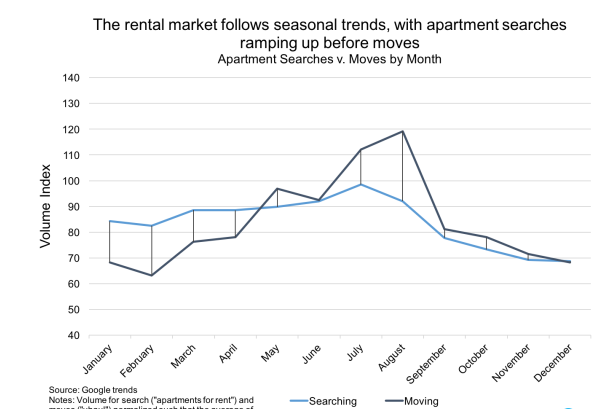
This issue of
The Residential Investor Connection delivers sound advice for Landlords and Tenants alike. Whether you are reading this on the
KRS Holdings site or
Great Richmond Rentals, you’ll profit from insight for both renters and residential real estate investors.

Rental Properties … the Law of Supply & Demand
The law of supply and demand was not formulated based on residential real estate. That said it is very much a reality when it comes to pricing of rental units … whether in multi-family residences or single-family homes.
Renters drive the demand side of the equation. Landlords create the supply. Seasonally each of these elements is affected and here’s why.
Renters’ seasonal moving preference is summer. That time of year for moves is motivated by three practical considerations:
- The kids are out of school. That means incentive to avoid switching schools or school districts mid-academic year.
- Weather is often a factor. Depending on the location, inclement weather may result in cancellations or delays of moves. That’s true in areas with severe climates, but also has impact in locations with less extreme weather … for example a rainy season.
- Job changes are frequent in the fall of the year. If the new job requires a move, doing so before the start-date is imperative.
In contrast, the final quarter of the year has as its hallmark the fewest moves. In addition to reasons listed above, that time of year tends to distract most of us with the expenses of getting kids back to school plus the anticipated financial and time commitments of the upcoming holiday season.
So tenants exhibit seasonal trends in both their search for rentals as well as the physical move. Here’s a graphic representation of both these activities.

As presented above, searches begin to accelerate following the Holidays and reach their crescendo in July. Somewhat in predictable lockstep, moves begin to increase in early spring and fast-track to their peak in August.
Alert Landlords understand this seasonal fluctuation in demand on the part of prospective tenants. Since it is an historical fact of life, residential rental investors need to recognize this phenomenon and formulate marketing and pricing strategies to successfully respond to the seasonal preferences of renters.
Landlords may make special offers regarding security deposits, upgrades or monthly rent.
Tip to Landlords: When making concessions to attract renters in the “off-season”, it pays to consider aligning the lease expiry date to get back on track with an annual lease that corresponds to peak moving months. For example, a new tenant in November may be presented with a lease that is up in April.
Note: Rental units in a growth market may not be subject to as broad swings in pricing as those in a more stable community. Growth markets usually are accompanied by increased housing demand as residents flock to an area with more to offer in jobs and quality of lifestyle.
Takeaways
Rental searches begin in the first two months of the New Year and continue on a constantly increasing incline through July. Moves are on an accelerating fast-track from March through August.
So as predicted by the law of supply and demand, rent prices tend to decrease as demand softens in the last quarter of the year.
Landlords will respond to weakened demand with special offers. Renters may benefit by choosing to move at a less desirable time of year when practical to do so.
 This issue of The Residential Investor Connection delivers sound advice for Landlords and Tenants alike. Whether you are reading this on the KRS Holdings site or Great Richmond Rentals, you’ll profit from insight for both renters and residential real estate investors.
This issue of The Residential Investor Connection delivers sound advice for Landlords and Tenants alike. Whether you are reading this on the KRS Holdings site or Great Richmond Rentals, you’ll profit from insight for both renters and residential real estate investors.

 As presented above, searches begin to accelerate following the Holidays and reach their crescendo in July. Somewhat in predictable lockstep, moves begin to increase in early spring and fast-track to their peak in August.
Alert Landlords understand this seasonal fluctuation in demand on the part of prospective tenants. Since it is an historical fact of life, residential rental investors need to recognize this phenomenon and formulate marketing and pricing strategies to successfully respond to the seasonal preferences of renters.
Landlords may make special offers regarding security deposits, upgrades or monthly rent.
Tip to Landlords: When making concessions to attract renters in the “off-season”, it pays to consider aligning the lease expiry date to get back on track with an annual lease that corresponds to peak moving months. For example, a new tenant in November may be presented with a lease that is up in April.
Note: Rental units in a growth market may not be subject to as broad swings in pricing as those in a more stable community. Growth markets usually are accompanied by increased housing demand as residents flock to an area with more to offer in jobs and quality of lifestyle.
As presented above, searches begin to accelerate following the Holidays and reach their crescendo in July. Somewhat in predictable lockstep, moves begin to increase in early spring and fast-track to their peak in August.
Alert Landlords understand this seasonal fluctuation in demand on the part of prospective tenants. Since it is an historical fact of life, residential rental investors need to recognize this phenomenon and formulate marketing and pricing strategies to successfully respond to the seasonal preferences of renters.
Landlords may make special offers regarding security deposits, upgrades or monthly rent.
Tip to Landlords: When making concessions to attract renters in the “off-season”, it pays to consider aligning the lease expiry date to get back on track with an annual lease that corresponds to peak moving months. For example, a new tenant in November may be presented with a lease that is up in April.
Note: Rental units in a growth market may not be subject to as broad swings in pricing as those in a more stable community. Growth markets usually are accompanied by increased housing demand as residents flock to an area with more to offer in jobs and quality of lifestyle.






